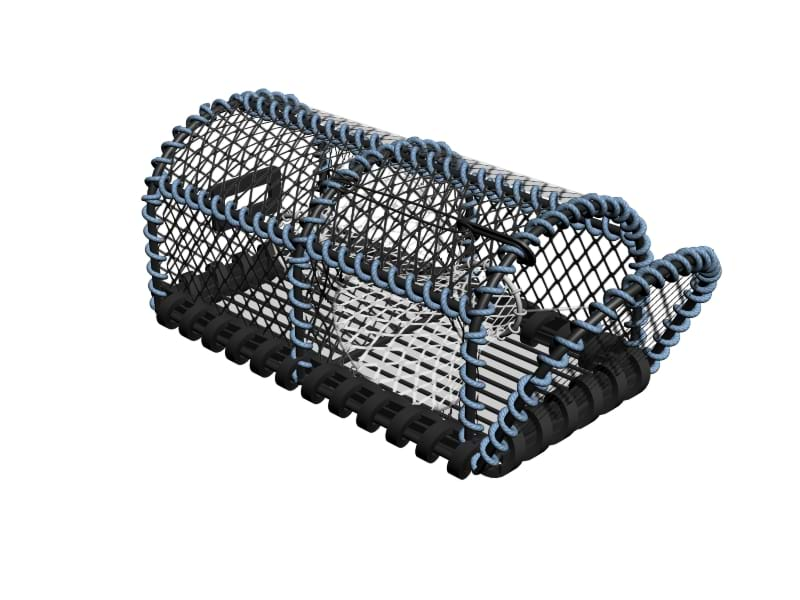Pots and Traps - Velvet Crab
Alternative names
-
- Creels
- Pots
- Traps
Summary
Traps or creels, used for velvet crab are similar to those used for lobster. They are also D shaped but are usually made slightly smaller and have two smaller entrances, one in each side. Many fishermen will use the same creels for velvet crabs as they do for lobster, just shooting them on different grounds and at different times of the year. They will be robustly constructed to be able to cope with the rocky grounds close inshore where the velvet crabs are found.

Environmental impact
By-catch in velvet crab creels is minimal and usually confined to small animals of the target species and a few small fish. This can be minimised by the use of appropriate mesh sizes in the cover netting and the use of relevant escape gaps. Any by-catch in the pots can be easily removed from the creel and released back into the sea immediately without harm. The hard eyes help to release any small fish that stray into the creels.
Seabed impact is minimal with creels shot to target velvet crabs. It will be limited to the creels themselves sitting on the seabed. The creels used are quite heavy and robust for working on shallow inshore grounds. They will not move on the seabed except in really bad weather, when this is imminent the fishermen will often move the gear into deeper water to prevent damage to the gear but also minimising the seabed abrasion and the chance of losing the gear.
There will be no seabed penetration as the habitat required for velvet crabs is the harder rocky seabeds and anchors are not usually used with this gear.
Ghost fishing is not that common with gear shot for velvet crabs. As they tend to be shot close inshore any lost gear will be very quickly washed up on the shore or damaged beyond repair by the wave action.
Even if these creels are lost it is common to use plastic rings (hard eyes) in the entrances that allows an easy escape from the trap for any fish or shellfish.
Other information
Velvet crab traps can either by shot individually or in strings (fleets), where a number of pots are attached to one long rope and laid on the seabed, with a dhan or bouy to mark the location of each end of the fleet. As velvet creels are often shot close inshore they will be worked as ‘single’ or smaller fleets than in most other trap fisheries
The pots are baited and shot away from the vessel as it steams slowly ahead and, are left on the seabed to fish and are generally hauled and rebaited every day. If left much more than overnight, there can be a tendency for some of the shellfish that are already in the traps to escape.
The pots are hauled by firstly picking up the dhan at the end of the fleet of pots and leading the rope to the creel hauler. The hauler is usually mounted forward, to one side of the vessel. As the pots are hauled up to the vessel, the creel hauler will be slowed down as the pots approach the vessel side. They will then be hauled, or manhandled, over the side of the vessel and onto a flat working table where the catch is removed and placed in a container for onboard sorting and processing before storage. As the catch is being taken out of the trap, any by-catch or undersized crabs and lobster will be immediately returned to the sea and the traps will be re-baited. The re-baited pots are passed across the deck and stowed in correct order so that they are all ready to be shot away again.
Velvet crabs are generally stored and transported in small lightweight wooden crates.
More information on the biology of the velvet crab can be found on the Marine Scotland website.
Documents
-
Escape gaps for velvet crabs (Necora puber); stock and economic benefits for the catching sector
-
The Transport Chain of Velvet Crabs from Orkney, the Western Isles and Northumberland to Spain - A Preliminary Review
Gear classification
Main target species (UK)
-
- Velvet Crab
Possible bycatch
-
- Brown Crab
- Crabs
- Lobster